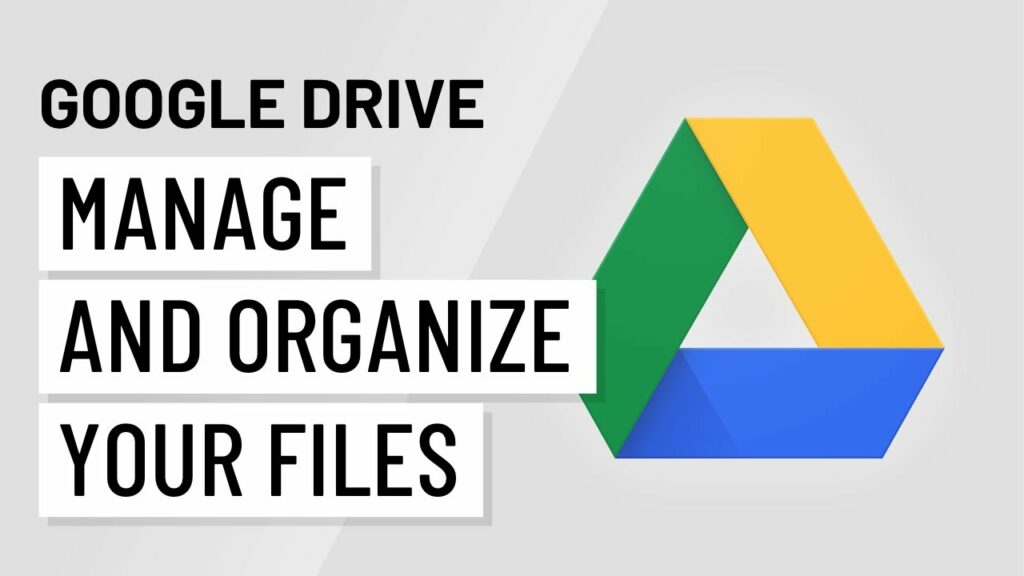Mastering the Digital Domain: A Comprehensive Guide to Managing and Organizing Your Google Drive Files

Introduction
In the vast landscape of digital information, effective file management is the linchpin that holds productivity and organization together. Google Drive, a powerful cloud-based storage solution, empowers users to store, share, and collaborate on files seamlessly. However, harnessing the full potential of Google Drive involves mastering the art of file management and organization. This comprehensive guide will take you on a deep dive into strategies, techniques, and best practices for managing and organizing your Google Drive files with efficiency and precision.
Understanding the Google Drive Interface
Before delving into advanced organization strategies, let’s familiarize ourselves with the Google Drive interface. Here are the key components:
- My Drive: Your personal storage space where you can create, upload, and organize files and folders.
- Shared Drives: Collaborative spaces for teams to store, access, and work on files together.
- Folders and Files: The basic building blocks of organization within Google Drive. Folders help group related files together, while files can include documents, spreadsheets, presentations, and more.
- Search Bar: A powerful tool for quickly finding specific files or folders within your Google Drive.
Fundamental Techniques for File Management
1. Creating Folders
Folders are the backbone of effective file organization. Follow these steps to create folders:
- Click on the “+ New” button.
- Select “Folder” from the dropdown menu.
- Name the folder and click “Create.”
Organize your folders based on projects, categories, or any system that aligns with your workflow.
2. Uploading Files
Efficient file management starts with uploading files to Google Drive. Use these steps to upload files:
- Click on the “+ New” button.
- Select “File upload” to upload individual files or choose “Folder upload” for multiple files within a folder.
- Locate and select the file(s) on your computer.
- Click “Open” to initiate the upload.
3. Moving and Copying Files
Once files are uploaded, you can move or copy them between folders:
- Right-click on the file or folder.
- Select “Move to” or “Copy to.”
- Choose the destination folder.
4. Renaming Files and Folders
Maintain clarity by giving meaningful names to files and folders:
- Right-click on the file or folder.
- Select “Rename.”
- Enter the new name and press “Enter.”
5. Utilizing Starred and Recent Sections
The “Starred” section allows you to bookmark important files, while the “Recent” section displays files you’ve accessed recently. Leverage these sections for quick access to crucial files.
Advanced Strategies for Effective Organization
1. Color-Coding Folders
Enhance visual organization by assigning colors to folders:
- Right-click on the folder.
- Select “Change color.”
- Choose a color from the palette.
Color-coded folders provide instant visual cues, making it easier to navigate your Google Drive.
2. Using Subfolders
For complex projects or extensive categories, create subfolders within folders:
- Right-click on the parent folder.
- Select “New folder.”
- Name the subfolder and click “Create.”
Subfolders offer a hierarchical structure for deeper organization.
3. Sorting and Filtering Options
Utilize sorting options to arrange files and folders based on name, date modified, or owner. Click on the column headers to sort, and use the filter options to narrow down your view.
4. Organizing Shared Drives
If you’re part of a team, leverage Shared Drives for collaborative projects:
- Click on “+ New” and select “Shared drive.”
- Name the Shared Drive and add members.
- Collaborate on files within the Shared Drive for a centralized workspace.
5. Utilizing Tags and Keywords
Harness the power of Google Drive’s search functionality by adding tags or keywords to files:
- Right-click on the file.
- Select “Add a tag.”
- Enter relevant keywords.
Tags make it easier to locate files using the search bar.
6. Removing Unused Files
Maintain a clutter-free Google Drive by regularly removing unnecessary files:
- Right-click on the file or folder.
- Select “Remove.”
- Choose between “Move to trash” or “Permanently delete.”
Empty the trash periodically to free up storage space.
7. Expanding Storage Capacity
If you find yourself running out of storage, consider upgrading your Google Drive storage plan:
- Click on the gear icon in the top-right corner.
- Select “Settings.”
- Choose “View storage plan” to explore options.
Optimizing Collaboration and Sharing
Google Drive’s collaborative features make it a powerful tool for team projects. Maximize collaboration by:
1. Sharing Folders
- Right-click on the folder.
- Select “Share.”
- Enter email addresses or generate a shareable link.
Set permissions to control who can view, comment, or edit the shared folder.
2. Real-Time Collaboration
Collaborate on Google Workspace files (Docs, Sheets, Slides) in real-time:
- Open the file.
- Share it with collaborators.
- Collaborators can edit simultaneously.
3. Setting Access Levels
For individual files, customize access levels:
- Right-click on the file.
- Select “Share.”
- Adjust access levels (Viewer, Commenter, Editor).
4. Collecting Feedback
Facilitate feedback on documents by:
- Sharing the document.
- Enabling commenting or suggesting mode.
- Collaborators can leave feedback directly in the document.
Security Measures for File Management
1. Two-Factor Authentication
Enhance the security of your Google Drive account by enabling two-factor authentication:
- Click on the gear icon.
- Select “View account.”
- Go to the “Security” section and enable two-factor authentication.
2. Reviewing Permissions
Regularly review permissions for shared files and folders:
- Right-click on the file or folder.
- Select “Share.”
- Review and modify permissions as needed.
3. Managing Version History
Google Drive automatically tracks version history for files. To access this feature:
- Right-click on the file.
- Select “Version history” and choose “See version history.”
Review and revert to previous versions if necessary.
Advanced Tips for Streamlining File Management
1. Automating Workflows with Google Apps Script
For users with coding skills, Google Apps Script offers automation possibilities:
- Click on the “+ New” button.
- Select “More” and choose “Google Apps Script.”
- Develop scripts to automate repetitive tasks.
2. Exploring Third-Party Integrations
Explore third-party apps and integrations available in the Google Workspace Marketplace:
- Click on the “+ New” button.
- Select “More” and choose “Connect more apps.”
Integrations can enhance Google Drive’s functionality.
3. Utilizing Google Drive Mobile App
Extend your file management capabilities to mobile devices:
- Download the Google Drive mobile app.
- Upload, access, and manage files on the go.
Conclusion
Efficiently managing and organizing your Google Drive files is not just a task; it’s a skill that enhances your digital workflow, collaboration, and overall productivity. By implementing the strategies outlined in this comprehensive guide, you’ll transform your Google Drive into a well-organized, collaborative, and secure space for all your digital assets. From fundamental techniques like creating folders to advanced strategies like color-coding and automated workflows, each step contributes to a harmonious and streamlined file management experience. As you navigate the ever-expanding digital landscape, your mastery of Google Drive file management will become a cornerstone of your digital productivity journey. Welcome to the realm where organization meets innovation, and the possibilities are as limitless as the cloud itself.




